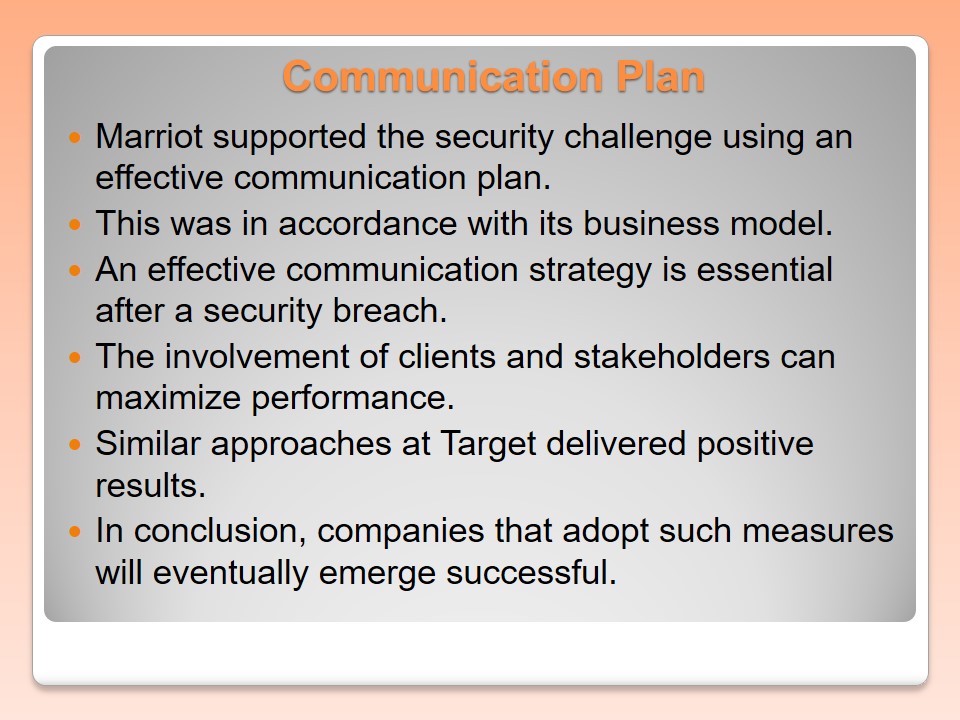Introduction
- Globalization and the Internet have transformed data transmission processes.
- Such developments have attracted attention of hackers and phishers.
- These criminals attack existing systems, thereby resulting in both financial losses and fines.
- Target and Marriott experienced similar breaches and losses in the past.
- Most of their customers were affected significantly.
- This presentation explains how these companies handled their security breaches.
Security breaches result in direct losses due to financial theft and indirect ones due to fines. Target is a leading retailer in the United States while Marriott is one of the corporations operating in the hospitality industry. In 2014, Marriott recorded losses amounting to around 600 million USD due to cyber attacks while those of Target were around 162 million USD in 2013. The case of these corporations’ cases reveals that evidence-based internal security frameworks could have prevented such losses. Powerful changes focusing on superior debit and credit card readers (EMV chips) could have improved the level of security.
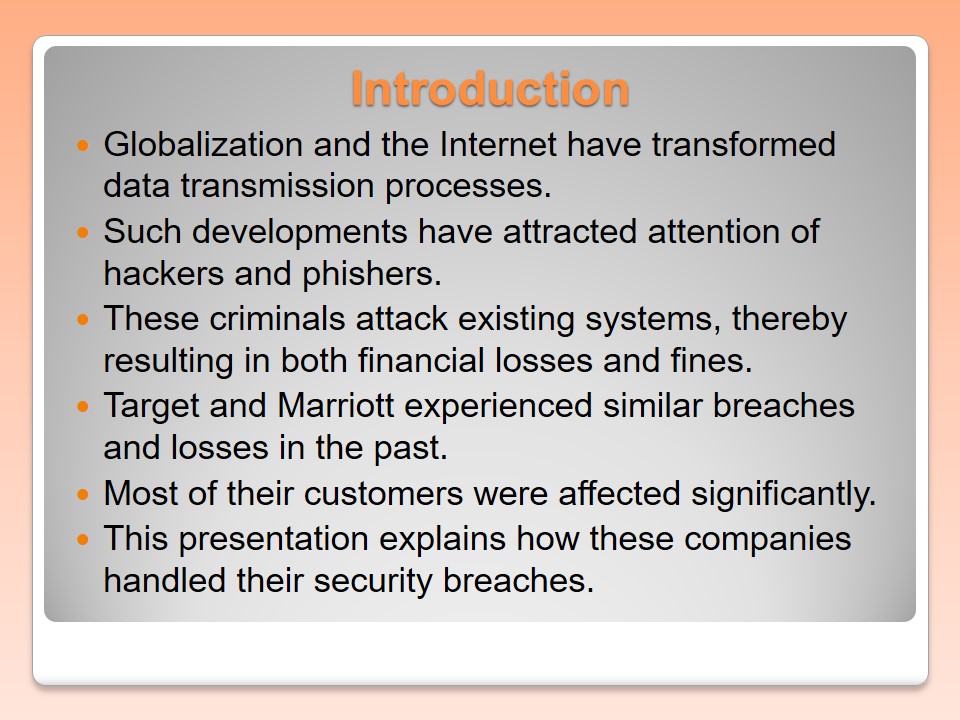
Change Analysis Summary
Navigator Role
- Target and Marriott embraced the Navigator role.
- Target focused on improved cyber-security options.
- Target wanted to secure the information contained in customers’ credit cards.
- Marriott also wanted to transform the situation after acquiring Starwood.
- This role is essential since it delivered positive results.
- These companies are currently improving their practices.
The Navigator role was effective for both Marriott and Target. Cybersecurity improvement measures supported Target’s objectives. The approaches resulted in more secure credit cards. Marriott also considered the most appropriate and sustainable strategies to transform the situation.
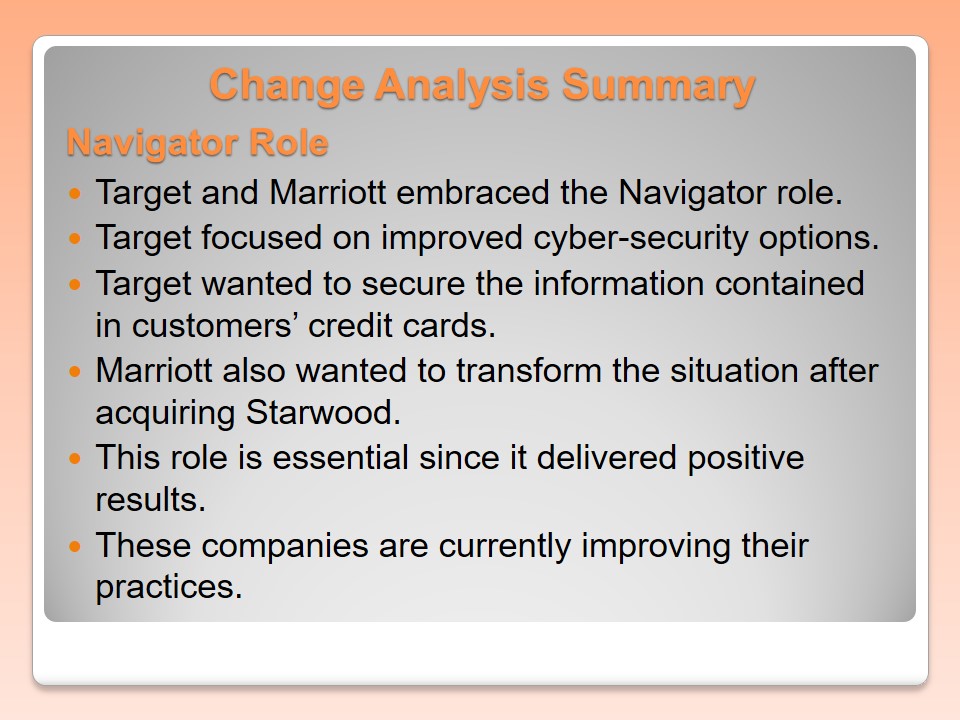
Caretaker Role
- The corporations’ caretakers pursued better public relations.
- Target encouraged customers to monitor their credit cards.
- Starwood owned the recorded security breach.
- Marriott implemented evidence-based approaches to rebuild customer confidence.
- These attributes supported the companies’ objectives.
- They also attracted and empowered more customers.
The initiatives the companies’ leaders undertook led to positive results. They managed to empower more customers after the two occurrences. All stakeholders were expected to be part of the process. New initiatives emerged to increase customer satisfaction.
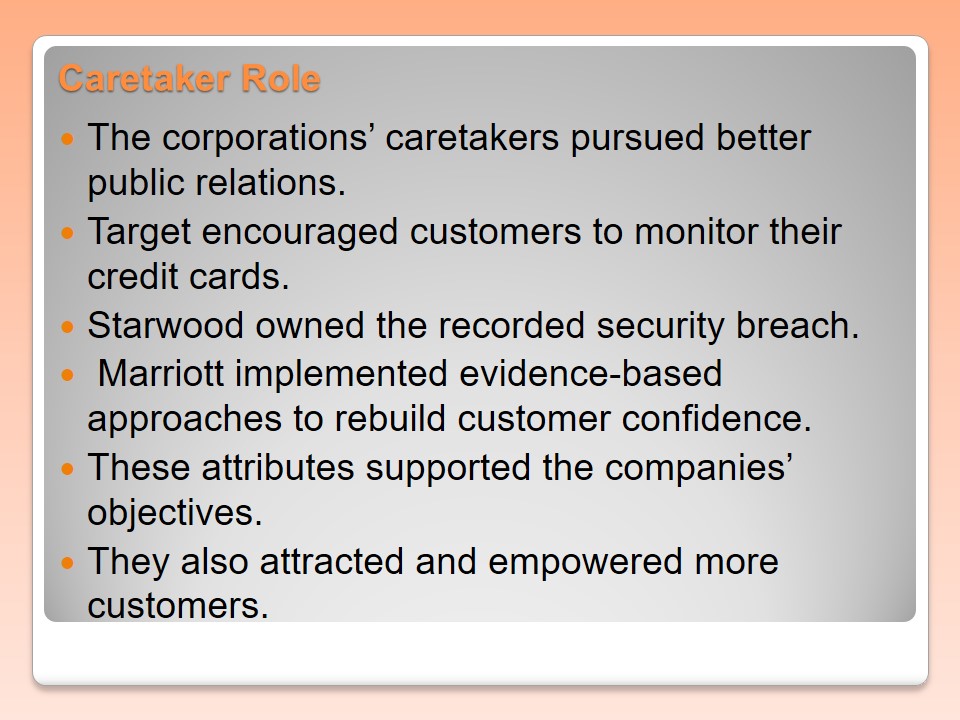
Coach Role
- From the Coach perspective, Target’s leaders felt responsible.
- The CEO decided to step down.
- Target remained serious to correct the mistake.
- Marriott blamed a third party for the breach.
- The details of Marriott’s breach remained unknown.
- These issues affected every company’s performance.
Target’s CEO chose to quit his position. With this kind of breach, it was appropriate for the companies to consider new initiatives to address the identified problem. They also introduced superior measures. However, Marriott remained less transparent regarding the nature of the security breach.
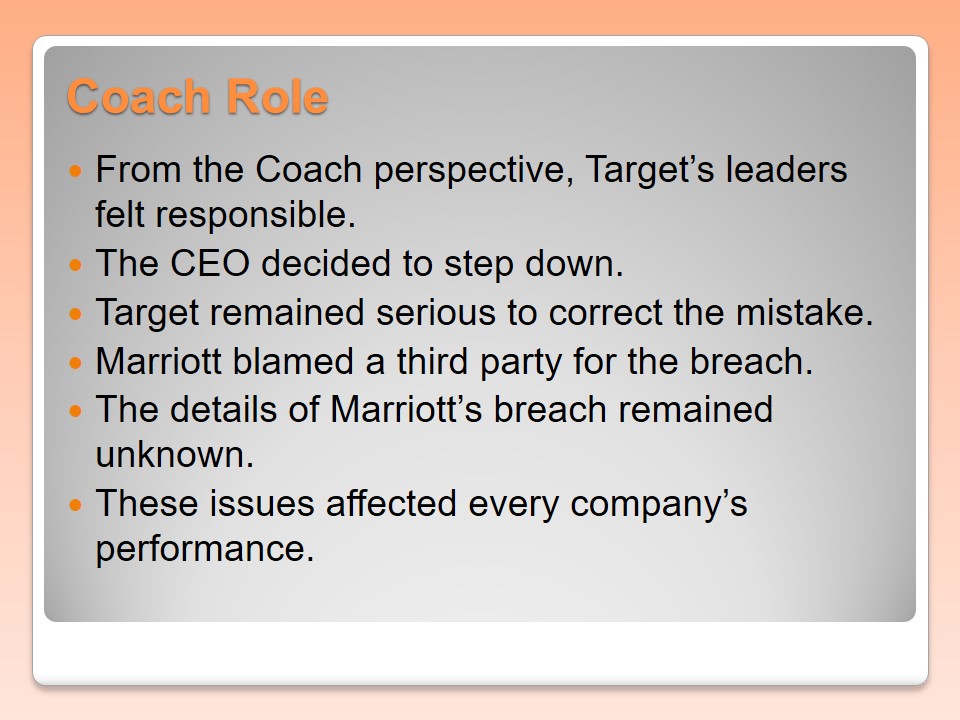
Marriott and Target in Retrospect
- The Navigator image would have supported the companies’ goals.
- Corporations should also control their external factors.
- They implemented the best communication process to the public.
- This approach guided the companies’ leaders to communicate the breach effectively.
- Marriott ignored the model, thereby disorienting its performance.
Change leaders should dictate customers’ experiences and goals. This means that they acted in the capacity of the Nurturer image. For Target, the leaders pursued the Navigator role by controlling the potential outcome after the attack. Gregg Steinhafel’s decision to step down increased customers’ trust levels. This decision predicted a real change under a new CEO, thereby preventing a potential future occurrence.
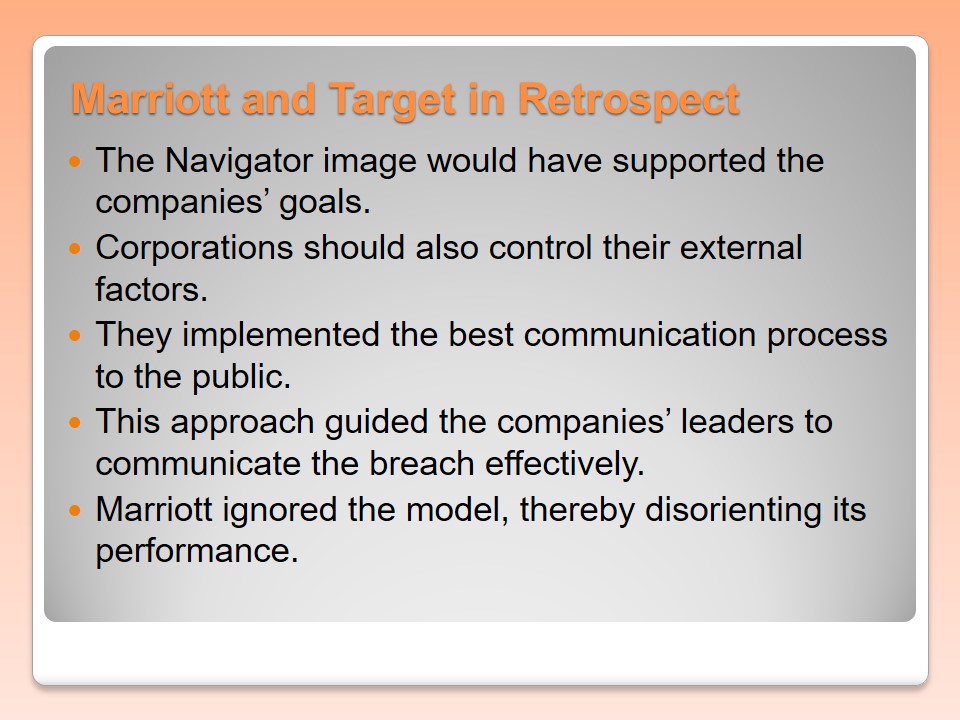
Determining the Change
Marriott
- The 7-S framework model was considered for these companies.
- Structure: A horizontal structure is evident.
- Strategy: A defensive model is used to deal with emerging issues.
- Systems: A powerful portal, social media, and a live chat.
- Style: Transparency is taken seriously to communicate to stakeholders.
- Competent auditors support this organization’s goals.
- Staff: Marriot offers training sessions to all employees.
- Diversified and international programs are common.
- Skills: Marriott encourages employees to develop the best competencies.
- Superordinate goals: Outlined values focus on the changing needs of customers.
- These measures have continued to deliver positive results.
Marriott uses a horizontal leadership model characterized by a CEO, departments’ vice presidents (VPs), executive managers, and legal counsels. It employs a defensive model strategy for the external environment. Its powerful portal guides customers and franchisees to access fields. It also employs these social media platforms to achieve its goals: Facebook, Instagram, YouTube, and Snapchat. When it comes to style, Marriott uses transparency and communicates effectively to stakeholders. It has independent auditors and engages in social responsibility activities.
Marriott offers evidence-based training opportunities for its staff members. The current model focuses on coaching, business basics, and stress management. This corporation also promotes competences in the field of hospitality. A wide range of values are always taken seriously, including excellence, change, integrity, and service for all.
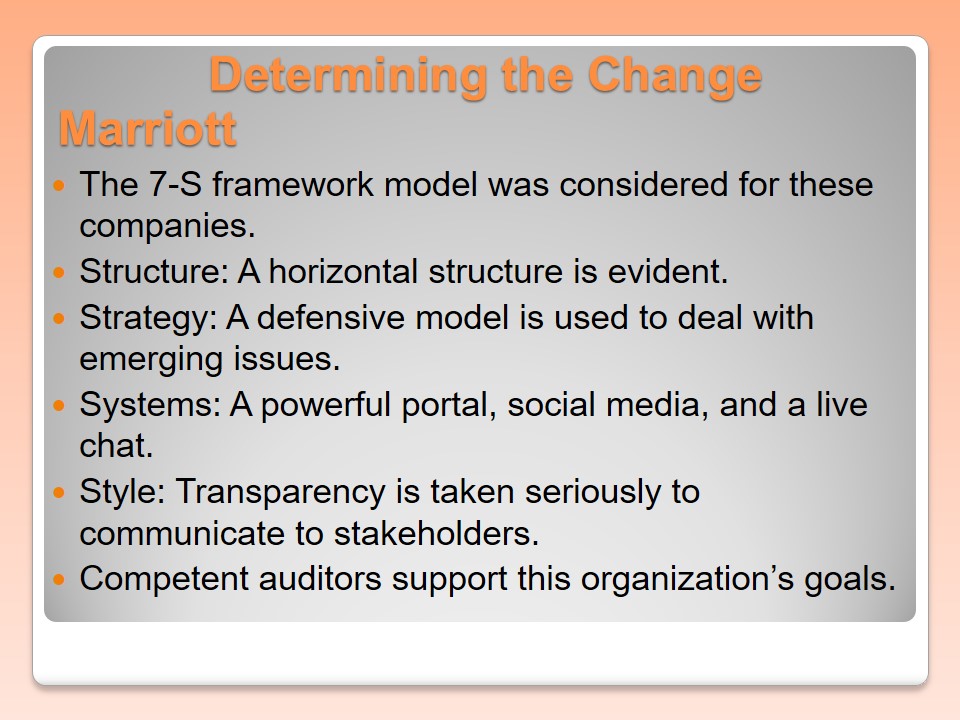

Target
- Structure: Target has a horizontal managerial structure.
- Strategy: Target’s strategy is that of preparedness and partnership.
- Systems: Target uses email alerts, webpage, and social medical.
- Style: Target uses its webpage too communicate to communities, customers, and employees.
- These initiatives continue to support the targeted goals.
- Staff: Target has an effective internship program aimed at fulfilling employees’ needs.
- Such an approach continues to drive organizational performance.
- Skills: Environmental responsibility is a critical strength of Target.
- Superordinate goals: Target’s values are aimed at improving internal and external connections.
- Emerging ideas are considered to meet customers’ needs .
- These attributes continue to make Target successful.
Target has a flexible managerial structure that empowers subordinates and employees to pursue their goals. It has also joined the Apparel Coalition to minimize its negative impacts on the environment. It is also the Energy Star Partner. When it comes to systems, Target has developed a multimedia platform that links emails, Facebook, YouTube, Instagram, Twitter, and Pinterest. Corporate social responsibility and environmental conservation initiatives are taken seriously.
Target’s staffing policy focuses on these key areas: software engineering, supply chain, operations managements, marketing, finance leadership, accounting, inventory analysis, product design, and business intelligence. It also sponsors the educational goals of every leader. Due to its CSR strategy, Target is currently one of the EPA’s Energy Star partners. Using its business model, this company finds it easier to give back to the society.
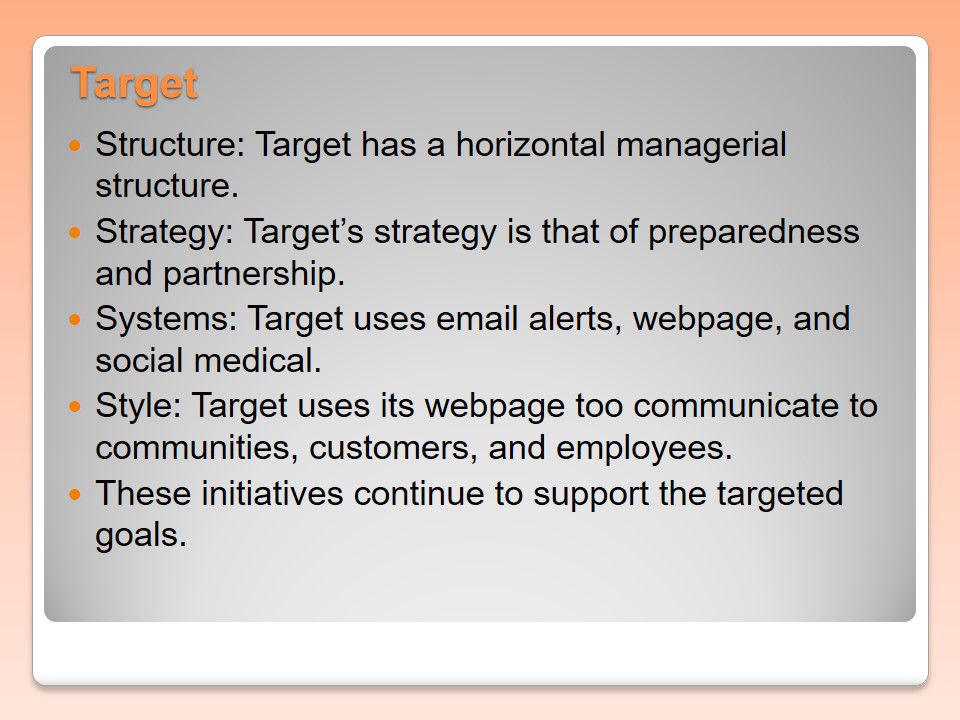
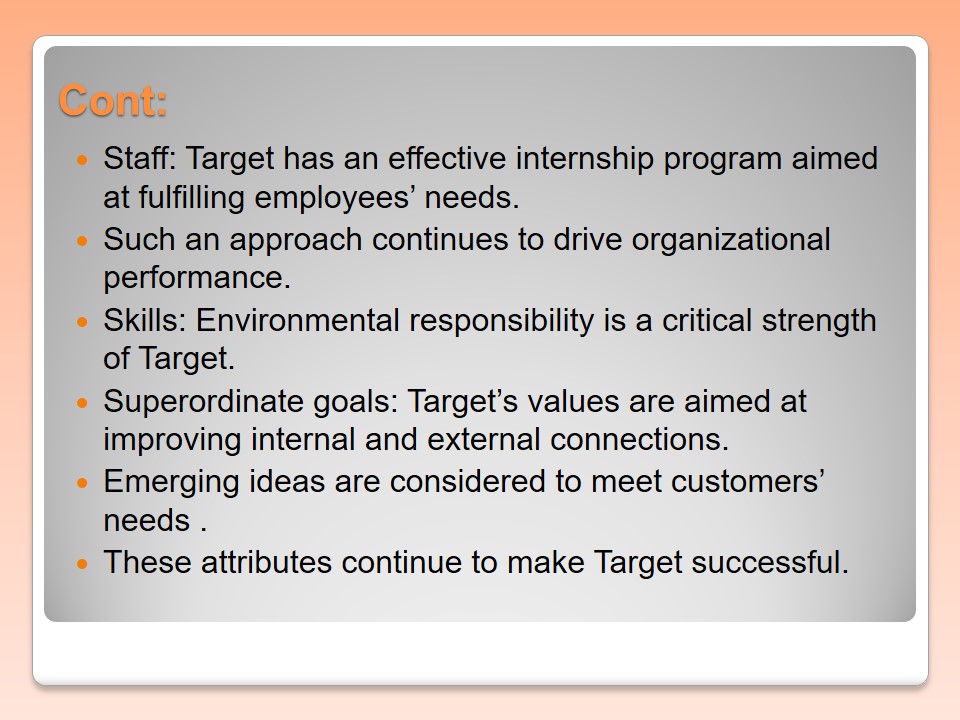
Force Field Analysis
- Marriott’s force for change is uniformity.
- Restricting force is the company’s management
- Target’s driving force for change is its consumer base.
- Target’s restricting force was its staff members.
- The CEO decided to step up in an attempt to reach equilibrium.
- These measures add value to these corporations.
Using the concept of uniformity, Marriott managed to transform its entire security system to achieve equilibrium. Additionally, the company’s management amounted to its restricting force. For Target, the driving force for change was its consumer base since it offered adequate support. Restricting force was its staff members. At Target, new changes were implemented to deal with this kind of security threat. To reach equilibrium, the company’s CEO chose to step down. Such measures support the actions and initiatives these organizations undertake.
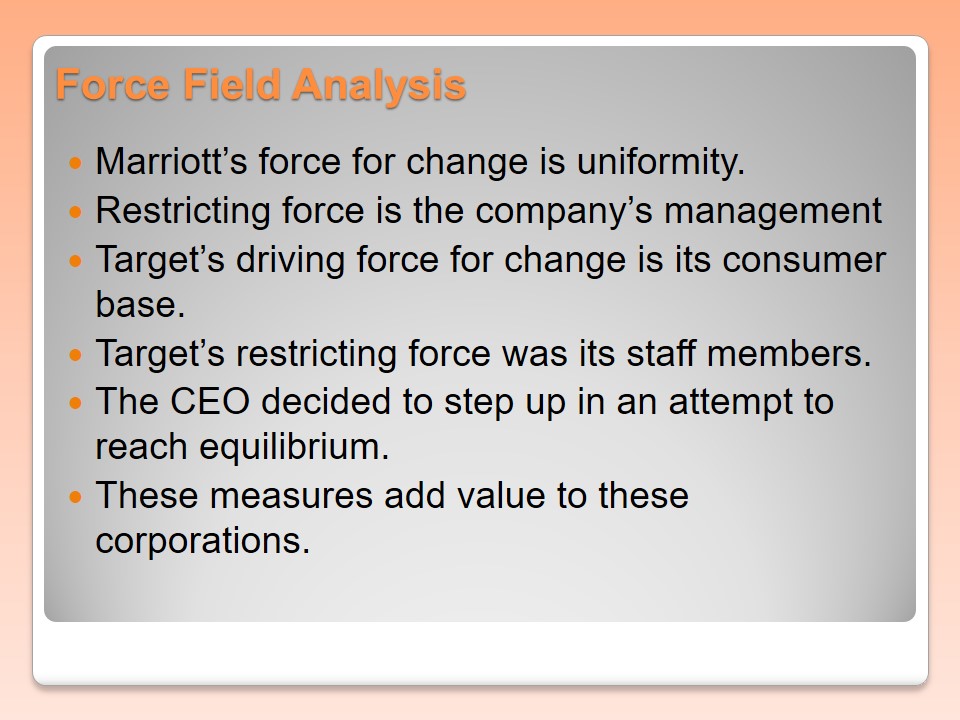
Marriott vs. Target: SWOT Analysis
- Strengths: Both companies have strong communication procedures.
- Weaknesses: Marriott’s response was defensive while Target approach catalyzed new challenges.
- Opportunities: Emerging data encryption technologies and consumer confidence.
- Threats: Future security breaches, competitors for Marriot, and increasing number of hackers.
- Value Judgment: Marriot managed to prevent future threats while Target implemented superior security measures.
Marriott has a clear communication process while Target’s upper management supports its model. The weakness for Marriott’s change process was the use of defense. The company also failed to take responsibility for the security break. Target acknowledged the breach but responded poorly in terms of communication, thereby being forced to issue secure credit cards. Both Target and Marriott focused on the best approaches to increase customer confidence and address their changing needs. They were also ready to comply with emerging norms in data encryption and customer privacy. Marriott is more vulnerable to security breaches due to its global presence. It has many competitors, such as Hilton. Increasing cases of hacking threaten Target’s business model and data. In terms of value judgment, Marriott has succeeded in preventing a potential future security breach. Target has also been transparent and has instituted appropriate preventative measures.
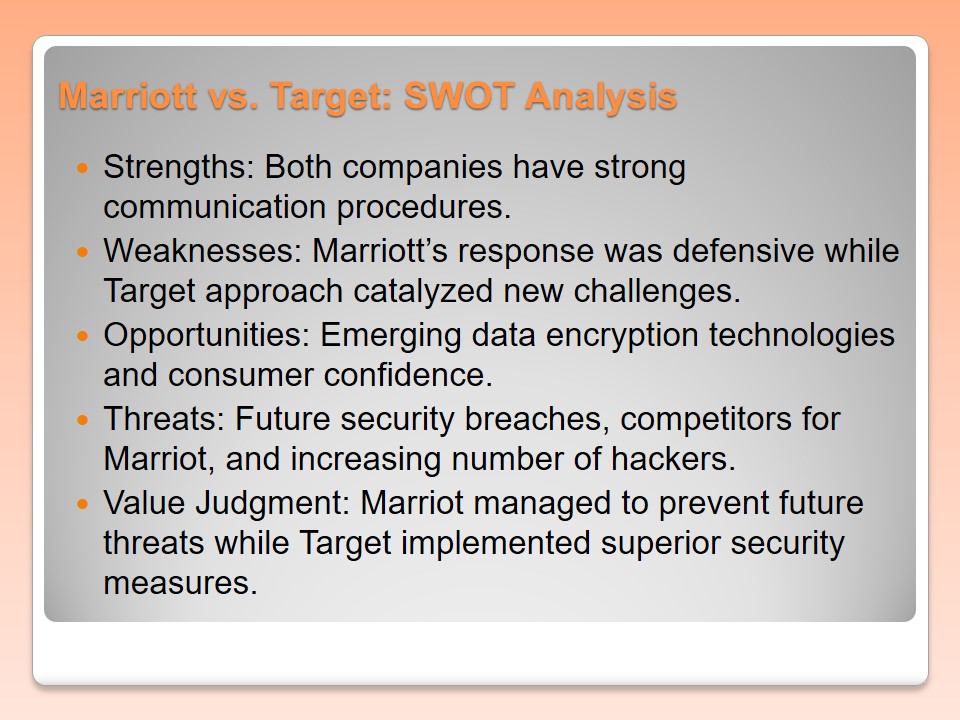
Areas of Resistance and Recommendations
- Potential Areas of Resistance:
- The inability of Marriot’s top leadership amounted to resistance.
- Target’s employees were not willing to be involved in this security issue.
- Recommendations:
- Powerful change management models can make a difference for the two corporations.
- They should also continue to embrace the Nurturer and Coach images.
- Superior security or preventative measures are needed.
Marriott’s change process encountered resistance from its managers since they did not accept the situation. For Target, the members of the staff were not ready to support the suggested decision. This means there were against the move to issue new debit cards to different customers. From this analysis, it is agreeable that both companies can embrace superior change management models. This is true since they were unprepared for any kind of a security breach. The Nurturer and Coach images can be appropriate for promoting inclusivity and developing a positive organizational culture. Thirdly, the companies can introduce evidence-based network security measures. The corporations’ managers can group their staff members by introducing new departments to monitor suspicious activities or actions.
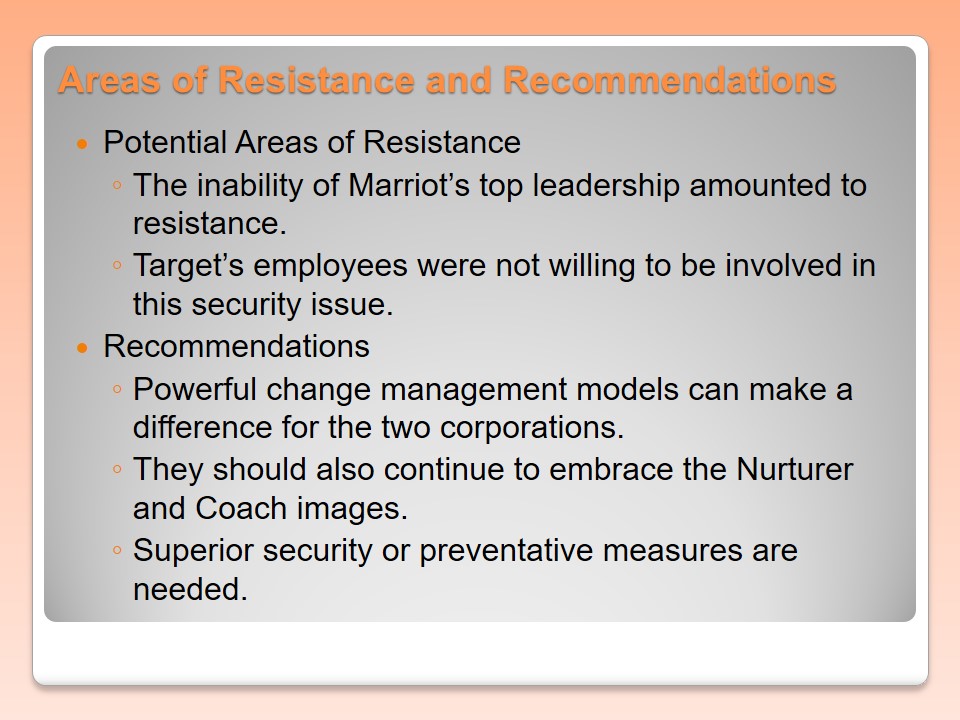
Communication Plan
- Marriot supported the security challenge using an effective communication plan.
- This was in accordance with its business model.
- An effective communication strategy is essential after a security breach.
- The involvement of clients and stakeholders can maximize performance.
- Similar approaches at Target delivered positive results.
- In conclusion, companies that adopt such measures will eventually emerge successful.
After recording the described security breach, Marriott implemented a powerful communication model to keep all stakeholders and customers informed. It followed the same culture that had been associated with the company after it was established several decades ago. It continues to update and share information regarding the introduction of superior systems, its collaboration with different firms, and the move to maximize the experiences of its customers. Additionally, the use of a powerful communication strategy continues to make it possible for Target to regain the confidence and trust of its customers. Marriott has also been detailing all operations aimed at meeting the needs of community members and individuals who are at risk of potential attacks. Consequently, the company’s number of customers has continued to increase significantly.
